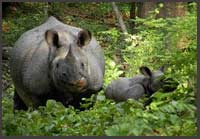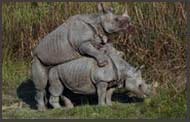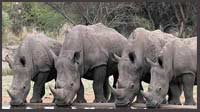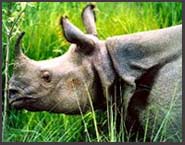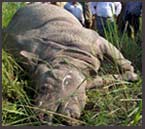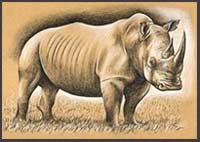Rhinoceros
Introduction
Page 1 of 7
The Indian Rhinoceros or Asian One-horned Rhinoceros or Greater One-horned Rhinoceros with the scientific
name Rhinoceros unicornis is the fourth or fifth largest of all the land animals.
Rhinoceros falls under the Rhinocerotidae family and order Perissodactyla. It is primarily spotted in the North-eastern India and the largest species among three other Rhino species which is widely spread around Asia.
Physical Structure
The skin of Indian Rhinoceros has a thick coat with the folds looking like plates of armor colored with silver brown or grayish and less body hair. The flexible skin between the armor helps to move from one place to another. They are distinct with other Rhino species by the single horn comprised of compressed keratin which is basically present in hair and fingernail. The shoulders and the upper part of the legs have wart-like bumps. They are characterized with wart-like bumps in the shoulder; neck and upper part of the legs which differentiate them from the Javan Rhino. The semi-prehensile lip helps Indian Rhino to feed on a wide variety of food like grasses, leaves, branches, aquatic plants and fruits.
Male Rhinos are larger than females. The Rhinoceros weighs about 1,800-3,000 kilogram (4,000-6,600 pounds) with the height ranging from 1.70 meter (5.70 feet) to 2 meter (6.5 feet). The girth or length of the body and head ranges from 3 meter to 3.8 meter (10feet to 12.5 feet). The horn is 8 to 24 inches (0.20 to 0.60 meter) in length. They are strong swimmers with the speed of 55km/hr and spend most of their time in water or mud holes to combat the heat during the hottest season. They possess a good hearing and smelling sense but have a poor vision. It has strong incisor teeth and two long canine teeth in its lower jaw.
Distribution and Habitat
Indian rhinos are spotted primarily in parts of north-eastern parts of the Indian subcontinent, in protected areas in the Terai at the foot of Himalayas, through the entire stretch of the Indo-Gangetic Plain. The majority of around 2,000 to 3,000 rhinos are found in Assam, an Indian state.
Page 2 of 7
Their habitats may include alluvial lands, flooded or riverine grasslands, swamp (marshy areas), tropical grasslands, tropical bush lands and reed beds.
Today, they are constrained to human surrounded habitats like near cultivated areas, pastures and secondary forests.
Places Found
The largest mammal can be found in the following national parks:
Kaziranga National park: This park is located near Furkating, state of Assam, India. This park has a very rich bio diversity which attracts the touristers and is a heart rending place. The most famous animals in this park are the One-horned Rhinoceros, Indian Elephants, Tigers,Indian Bison, etc
Manas National Park or Manas Wildlife Sanctuary:
This is a wildlife sanctuary, UNESCO Natural World Heritage site, a Project Tiger Reserve. Located in the Himalayan foothills, it is conterminous with the Royal Manas National park in Bhutan. Manas Tiger reserve was created in 1973; total area of the sanctuary is 360 kms. The name of the park originated from the Manas River, which is named after the snake goddess Manasa.
Dudhwa National Park : It is located in the Terai or marshy lowlands of Uttar Pradesh in India with an area of 811 sq. Kilometers of marshes, grasslands and dense forest. The fauna here includes around 38 species of mammals like One-horned rhinoceros, Swamp deer, Hog deer, Tiger, leopard, sambar, wild boar, etc.
Jaldapara Wildlife Sanctuary: It is a protected park located at the foothills of Eastern Himalayas in Jalpaiguri District in West Bengal and on the banks of the river Torsa which has an area of 141 km. It is a vast grassland with riverine forests. The main attraction of the park is the Asiatic one-horned rhinoceros after Kaziranga National Park. The other fauna are Tigers, deers, elephant, sambhar, barking deer, etc. The other national parks where rhinos could be spotted are Pobitora Wildlife Sanctuary, Katerniaghat Sanctuary, Orang Sanctuary and Gorumara Sanctuary
Food Habits
Indian Rhinos are herbivores and feed mainly on vegetarian foods. Their food may vary depending on their habitat. They prefer to eat grass when they are in grasslands, flood plain areas and swamps. Occasionally they eat fruits, leaves and branches when they live in dense forest area. They feed on farm crops when populated in the cultivated areas. When they are in water they dive and consume aquatic plants. Their prehensile lips help them to grasp and pull out the grass and aquatic plants by the roots. They also help to feed on leaves, branches, aquatic plants and fruits.
Page 3 of 7
Mating Behaviour:
The female rhinos reach sexual maturity at the age of 4 years to 7 years and the males between the ages of 8 years to 10 years.
The female informs about her maturity to the male with a whistling sound. The male with its enhanced olfactory sense find which females are ready for mating. The male rhino fight each during the mating season to make a successful courtship with the female which at times may lead to death. The mating takes place throughout the year.
The gestation period may last for about 460 to 490 days (15-16 months) during which the male rhino doesn't accompany them. Finally, the female give birth to a single baby rhino. They are hornless during their birth and weighs about 60 kg and with a length of 105 cm. They are weaned by their mother for about 640 days (18 months). After this period the calf is set independent. Generally, females give birth once in every three years. The Rhinoceros may live at a maximum of 40-47 years of age.
Species of Rhinoceros
Other than Indian Rhino there are 4 species of Rhinoceros existing around the world. They are specified below:
| Common name |
Zoological name |
Found at |
IUCN listing |
Picture |
| White Rhinoceros |
Ceratotherium simum |
South Africa |
Extinct except 6 |
 |
| Black Rhinoceros |
Diceros bicornis |
South-central, south-western, East African, West African parts of the world |
Critically Endangered |
 |
| Javan Rhinoceros |
Rhinoceros sondaicus |
Java (Indonesia) and Vietnam |
Extinction in India, Burma, Peninsular Malaysia, and Sumatra |
 |
| Sumatran Rhinoceros |
Dicerorhinus sumatrensis |
Borneo and Sumatra |
Critically Endangered |
 |
Page 4 of 7
Population of Indian Rhinoceros in India:
>
The population census in May 2007 estimated the population of Indian Rhinoceros to be as given below in the table.
| Country |
Rhino population |
| India |
2200 |
| Nepal |
378 |
| Total |
2578 |
The total population estimate of May 2007 states that although there has been some population decline in recent years, they could notice the population increase when the overall population is considered.
The population of One-horned Rhinoceros in India as of May 2006-2007 in various places is as below:
| National parks in India |
Rhino count |
| Dudhwa National Park |
21 |
| Manas National Park |
3 |
| Karteniaghat |
2 |
| Kaziranga National Park |
1855 |
| Orang |
68 |
| Pabitora |
81 |
| Jaldapara |
108 |
| Gorumara |
27 |
| Small population around India |
35 |
| Total |
2200 |
With reference to above, Kaziranga National Park is the well established Rhino reserve since 1905 with the highest One-horned Rhinoceros population hitting about 70 percent of over Indian Rhino population. Overall increase in population could be noted in the area like Kaziranga, Pabitora, Dudhwa, Jaldapara and Gorumara, while the decline in population can be spotted in areas like Manas, Orang and Laokhowa. The population is transient in Karteniaghat.
Page 5 of 7
Threats to Indian Rhinoceros
Indian Rhinoceros are declining in their population
and marked as the 'Endangered Species' by IUCN due to the factors like habitat loss, poaching, human-rhino conflict, Rhino-rhino conflict. The major threats that the Indian rhinos are facing are by the humans living near the sanctuary. It has become essential to include people in the conservation efforts. The park borders can be combined to avoid the human-rhino clash.
Habitat Loss
Habitat loss for these mammals occur due to below situation:
• The alluvial plain grasslands are converted to agricultural lands
• The reduction in the grasslands and wetland habitats because of woodland encroachment and the silting up of ponds.
• Due to graze of various live stocks.
• Some reports mention that grassland area in Chitwan has been decreased from 20% to 47% of the national park.
• The grazing, human encroachment and silting up has been noticed in Orang National park which directly causes the decline in Rhino population.
• In Pabitora there has been an invasion of woodland to conversion to grassland and siltation and drying up of various water body sources. In addition to this there has been marked human encroachment and very severe livestock grazing.
Poching
Poaching is one of the threats which many mammals are facing. The poaching can be widely inferred in Kaziranga which has the largest population of One-horned Rhino. The rhinos are poached for the below reasons:
• The horn of the rhinos is plundered for trade since they are used in Chinese medicine and Siddha medicine to cure various diseases and as an ornamental dagger or weapon handle.
Page 6 of 7
• Their hard skin is also poached for medicinal use in various countries like Taiwan, China, Hong Kong and Singapore.
Because of the above reasons there has been a consistent decrease in the population of rhinos in various areas.
Human - Rhino ConflictThis conflict arises when the human and Rhinoceros are in direct interaction. Since the alluvial lands are converted to the human usable agricultural development land, the rhinos are adapting their living in the agricultural lands. This becomes an advantage for the hunters to hunt these mammals for their use. Sport hunting of rhinos is also followed in different areas.
The population of rhino in some areas is very less and the sex ratio among the adult ones is nearing 1:1. Eventually, the fights among the male rhinos arises which in fact is very dangerous and leads to death or straying out of the animal.
Conservation Effort in India
The government of India has taken major steps towards the conservation of Indian Rhinoceros. This is done with the help of the World Wide Fund for Nature (WWF) and other private organizations.
Since Kaziranga has the 70% of the Rhino population, steps have been taken to extend the park area and it has been neatly fenced in order to protect the rhinoceros being strayed out or hunted by poachers and also to minimize the human-rhino conflict. Programmes are being conducted with the intention to improve the habitat of Rhinos and weed control.
In Pabitora, recommendations have been made to improve the feeding habitat of Rhino and reduce the livestock grazing. In addition water hold mechanism is suggested to be introduced with the intent to keep the grassland available during winter season also.
With the assistance of International Union for Conservation of Nature and Natural Resources (IUCN), Species Survival Commission (SSC), Asian Rhino Specialist group and Indian Rhino vision 2020 has been developed. These cover the below conservation measures:
Page 7 of 7
• Translocating rhinos to highly populated Rhino areas and start new population.
• Improving the security around the Rhino populated parks thereby reducing poaching.
• Analyzing the habitat status and management needs in the rhino populated parks.
• Expanding the current quality habitat.
• Improving the infrastructure in the protected areas and reducing human-wildlife conflicts.
• Training staff are allocated for specific rhino conservation techniques.
• Creating awareness among people and making them involve in the Rhino conservation.
Indian Rhinoceros as a symbol in various religions
• In Greek mythology, it is believed that the horn of rhinoceros has the ability to clean or purify the water.
• The Persians believed that rhino horn vessels has the power to detect poisoned substances.
Interesting Facts
1. The Indian Rhinoceros can run 35 miles (55 kilometers) an hour.
2. They are solitary animals.
3. The horns of Indian Rhinos when mixed with water is used as the medicine for madness, pitha, thirst, dryness, venereal disease, pulmonary disease, burning sensation, fatigue and heat caused by indigestion of poison, etc.
4. The parpam made from the horn of Rhinos are useful to cure asthma.
5. The skin of the animal when mixed with water is used as a medicine to control madness.


